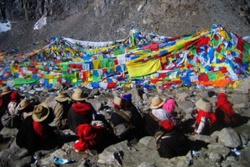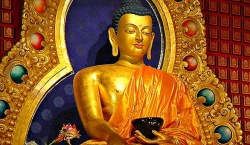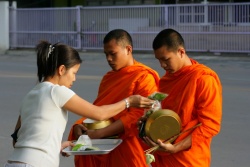Introduction to the Karma family
Karma means action, momentum, and movement. Quite appropriately, the Wind element is also associated with the Karma Family as well. Just as the wind can be still and calm, or light, or steady, or powerful and even violent, karma energy can act in the same way.
The passive energy of the Karma family is Confidence and the active energy is Acting, Moving, Controlling, or Transforming. This energy involves the first impulses and the first moments of motion towards "Other" from the position of Self.
Creativity is also involved in this energy. Therefore the body part is the groin and reproductive organs. This area of the body is also connected with Will-Power, intention, life-force, and vitality which are all part of the Karma family energy.
Intention is the Collection associated with the Karma Family. This involves our goals, values, and will-power. It includes the feelings of capability and incapacity. It concerns all of the things that motivate us or compel us to think, speak, and act. This includes our habitual tendencies which is our Karma.
The term "Cause and Effect" is not a good translation of the term Karma. This came about from people who had little understanding of Buddhism combined with people who had little understanding of English. A better term that is now being used is "Dependent Arising".
People around Buddha's time and earlier had words that contained very large concepts, so that the term "Karma" or "Action" also included the circumstances that arose with the action and everything that arose as a result of the action. A whole set of circumstances arises together. Included in that arising is our own tendency or impulse. This is our completing karma from the past coming to fruition. How we respond to those circumstances and how we respond to our own impulses becomes our Throwing karma which then creates or reinforces conditions for the future. That is the real definition of Karma.
We need to recognize that thoughts and feelings are actions. Complete stillness is what happens before thoughts, feelings, and perceptions and so, from that viewpoint, even a thought is an action. Thanks to Shamata meditation, we develop the ability to perceive the space in which thought, speech, and action take place. We can therefore become aware of the very beginnings of the actions of thinking and feeling. Because of that, we can determine the final expressions of our thoughts and feelings. That extra sense of space allows us to catch neurotic expressions before they are completed and change them into wise expressions of the same energy.
When we grasp at or are carried away by this energy, we are usually restless and full of busy-ness. We also tend to be paranoid, because we're always afraid that we are going to miss something, or that there are things that are not getting done that need to be done. There is a very strong need to always be in control or to try to be aware of and control everything.
When we resist or feel a lack of Karma energy, we can become envious and jealous of the abilities and acquisitions of others. We can avoid or deny the need for things that require too much effort or we avoid setting goals that we feel are too involved for us.
When we are overwhelmed by Karma energy then we develop low self-esteem. We develop the feeling that we do not have the ability, intelligence, drive, or circumstances to get what we want or need. We doubt our own abilities, and we develop doubt about all aspects of the workings of the world around us.
The Wisdom of Karma is Creativity and Skillful Action. We recognize all of the resources that are at our disposal for the process of creation. We recognize the value of creating causes and conditions in a deliberate manner because we know ahead of time what the results will be. This includes the feeling of joy in the process of creation.
The Quality associated with the Karma family is Perseverance. We continue to make effort until we achieve whatever goal we have set. It includes Enthusiasm, because we recognize that all we need to do to obtain something is to create the proper causes and conditions. Perseverance and Enthusiasm help to counteract Envy, Jealousy, and low self-esteem. We recognize that obtaining the object of our desire or achieving our goal comes automatically once the proper causes and conditions are set in motion.
The colour associated with the Karma Family is green. This is the green of springtime, the season of creativity and reproduction. Karma energy is warm and stirring. It represents growth and accomplishment.
The Buddha of the Karma Family is Amoghasiddhi. He represents Skillfulness and purified Intention. His Consort is SamayaTara who represents creativity and the purified wind element. They are both green in colour. Green Tara is usually the one prayed to in Tibetan Buddhism for the removal of obstacles.


